Google's Communication, Knowledge, and Information Management
VerifiedAdded on 2019/12/04
|8
|2156
|157
Report
AI Summary
This report delves into the crucial aspects of managing communication, knowledge, and information within an organization, utilizing Google as a primary case study. It explores the significance of data collection, assessment, and exchange to facilitate effective decision-making and policy formulation. The report examines various strategic, tactical, and operational information levels within Google, highlighting the importance of both internal and external data sources in achieving business objectives. Scenario 1 focuses on Google's expansion plans in the UK market, analyzing the range of decisions required, the information needed for effective decision-making, and recommendations for enhancing the management team. Scenario 2 addresses stakeholder identification, communication methods, and strategies for involving stakeholders in the decision-making process, particularly in the context of opening a new Google store in Kent, UK. The report concludes by emphasizing the pivotal role of information management strategies in achieving organizational goals, underscoring Google's commitment to leveraging these strategies for continued success.
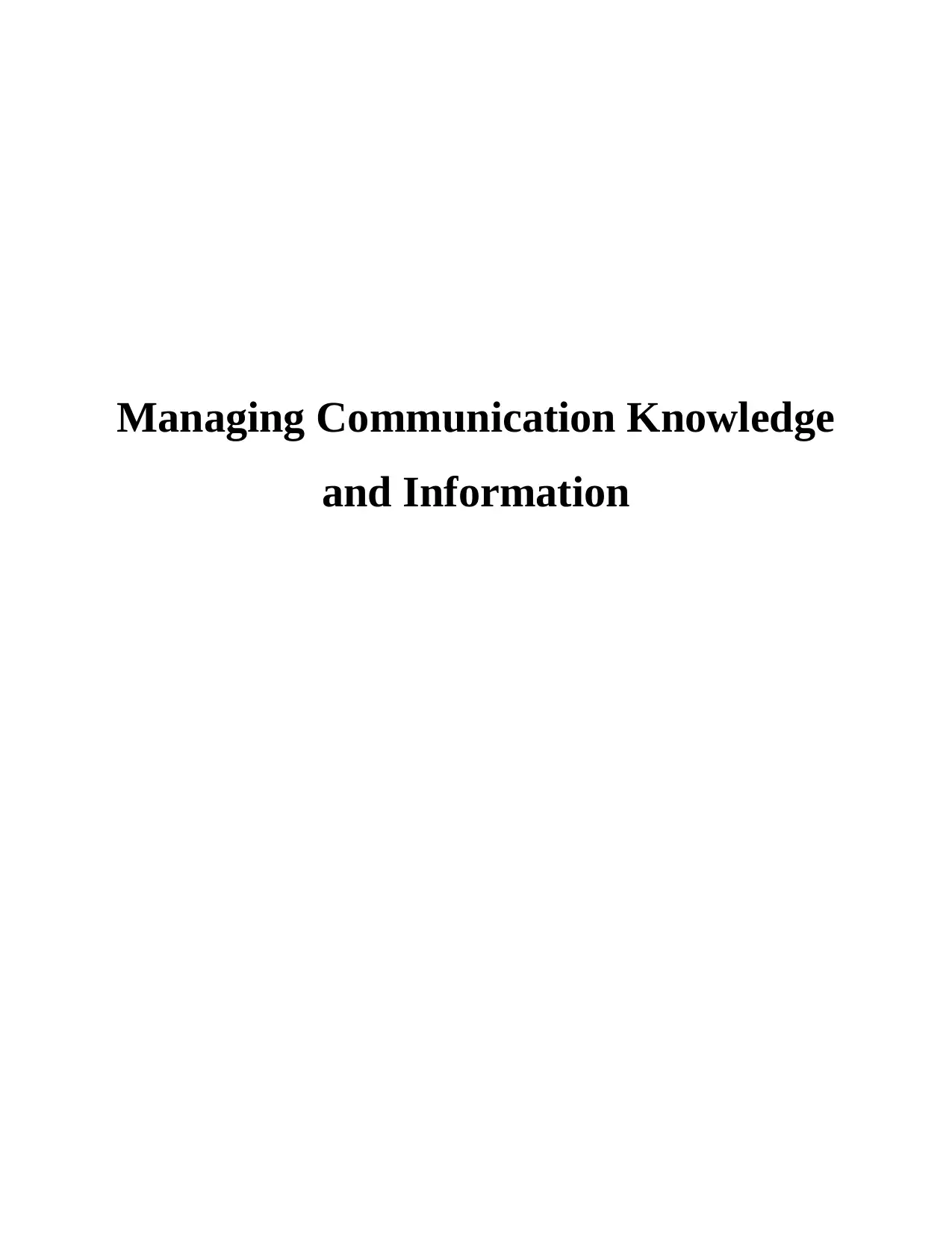
Managing Communication Knowledge
and Information
and Information
Paraphrase This Document
Need a fresh take? Get an instant paraphrase of this document with our AI Paraphraser

TABLE OF CONTENTS
INTRODUCTION...........................................................................................................................1
SCENARIO 1...................................................................................................................................1
1.1 The range of decisions to be taken by the company.........................................................1
1.2 Examining information and knowledge needed to ensure effective decision making.....1
1.3 Assessment of internal and external sources of information and understanding.............2
1.4 Recommendations for improvement of management team..............................................3
SCENARIO 2...................................................................................................................................3
2.1 Identifying stakeholders for decision making process.....................................................3
2.2 Establishing contact with the stakeholders through various modes.................................4
2.3 Involving the stakeholders in decision-making................................................................5
2.4 Designing strategies to make the event memorable.........................................................5
CONCLUSION................................................................................................................................5
REFERENCES................................................................................................................................7
INTRODUCTION...........................................................................................................................1
SCENARIO 1...................................................................................................................................1
1.1 The range of decisions to be taken by the company.........................................................1
1.2 Examining information and knowledge needed to ensure effective decision making.....1
1.3 Assessment of internal and external sources of information and understanding.............2
1.4 Recommendations for improvement of management team..............................................3
SCENARIO 2...................................................................................................................................3
2.1 Identifying stakeholders for decision making process.....................................................3
2.2 Establishing contact with the stakeholders through various modes.................................4
2.3 Involving the stakeholders in decision-making................................................................5
2.4 Designing strategies to make the event memorable.........................................................5
CONCLUSION................................................................................................................................5
REFERENCES................................................................................................................................7
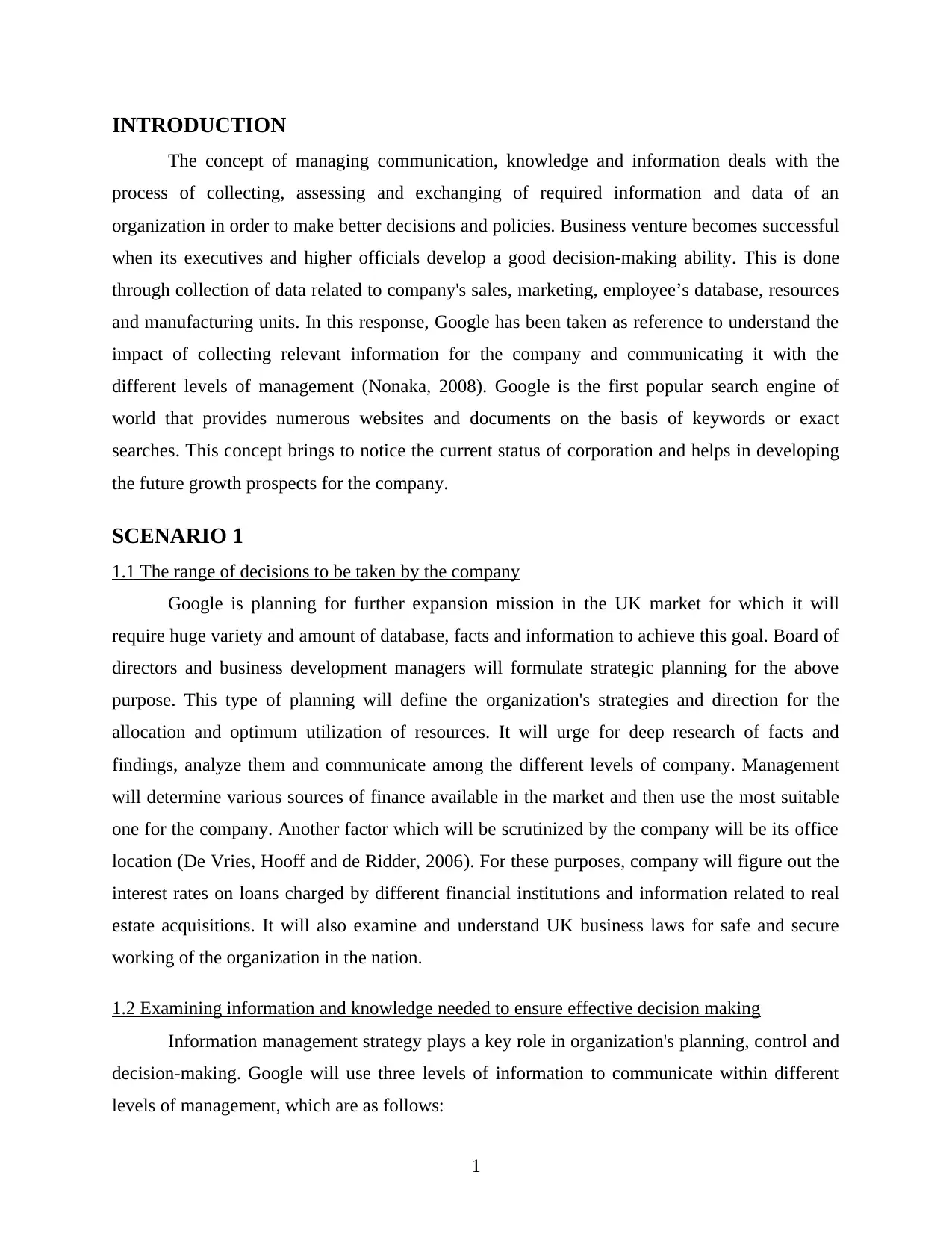
INTRODUCTION
The concept of managing communication, knowledge and information deals with the
process of collecting, assessing and exchanging of required information and data of an
organization in order to make better decisions and policies. Business venture becomes successful
when its executives and higher officials develop a good decision-making ability. This is done
through collection of data related to company's sales, marketing, employee’s database, resources
and manufacturing units. In this response, Google has been taken as reference to understand the
impact of collecting relevant information for the company and communicating it with the
different levels of management (Nonaka, 2008). Google is the first popular search engine of
world that provides numerous websites and documents on the basis of keywords or exact
searches. This concept brings to notice the current status of corporation and helps in developing
the future growth prospects for the company.
SCENARIO 1
1.1 The range of decisions to be taken by the company
Google is planning for further expansion mission in the UK market for which it will
require huge variety and amount of database, facts and information to achieve this goal. Board of
directors and business development managers will formulate strategic planning for the above
purpose. This type of planning will define the organization's strategies and direction for the
allocation and optimum utilization of resources. It will urge for deep research of facts and
findings, analyze them and communicate among the different levels of company. Management
will determine various sources of finance available in the market and then use the most suitable
one for the company. Another factor which will be scrutinized by the company will be its office
location (De Vries, Hooff and de Ridder, 2006). For these purposes, company will figure out the
interest rates on loans charged by different financial institutions and information related to real
estate acquisitions. It will also examine and understand UK business laws for safe and secure
working of the organization in the nation.
1.2 Examining information and knowledge needed to ensure effective decision making
Information management strategy plays a key role in organization's planning, control and
decision-making. Google will use three levels of information to communicate within different
levels of management, which are as follows:
1
The concept of managing communication, knowledge and information deals with the
process of collecting, assessing and exchanging of required information and data of an
organization in order to make better decisions and policies. Business venture becomes successful
when its executives and higher officials develop a good decision-making ability. This is done
through collection of data related to company's sales, marketing, employee’s database, resources
and manufacturing units. In this response, Google has been taken as reference to understand the
impact of collecting relevant information for the company and communicating it with the
different levels of management (Nonaka, 2008). Google is the first popular search engine of
world that provides numerous websites and documents on the basis of keywords or exact
searches. This concept brings to notice the current status of corporation and helps in developing
the future growth prospects for the company.
SCENARIO 1
1.1 The range of decisions to be taken by the company
Google is planning for further expansion mission in the UK market for which it will
require huge variety and amount of database, facts and information to achieve this goal. Board of
directors and business development managers will formulate strategic planning for the above
purpose. This type of planning will define the organization's strategies and direction for the
allocation and optimum utilization of resources. It will urge for deep research of facts and
findings, analyze them and communicate among the different levels of company. Management
will determine various sources of finance available in the market and then use the most suitable
one for the company. Another factor which will be scrutinized by the company will be its office
location (De Vries, Hooff and de Ridder, 2006). For these purposes, company will figure out the
interest rates on loans charged by different financial institutions and information related to real
estate acquisitions. It will also examine and understand UK business laws for safe and secure
working of the organization in the nation.
1.2 Examining information and knowledge needed to ensure effective decision making
Information management strategy plays a key role in organization's planning, control and
decision-making. Google will use three levels of information to communicate within different
levels of management, which are as follows:
1
⊘ This is a preview!⊘
Do you want full access?
Subscribe today to unlock all pages.

Trusted by 1+ million students worldwide
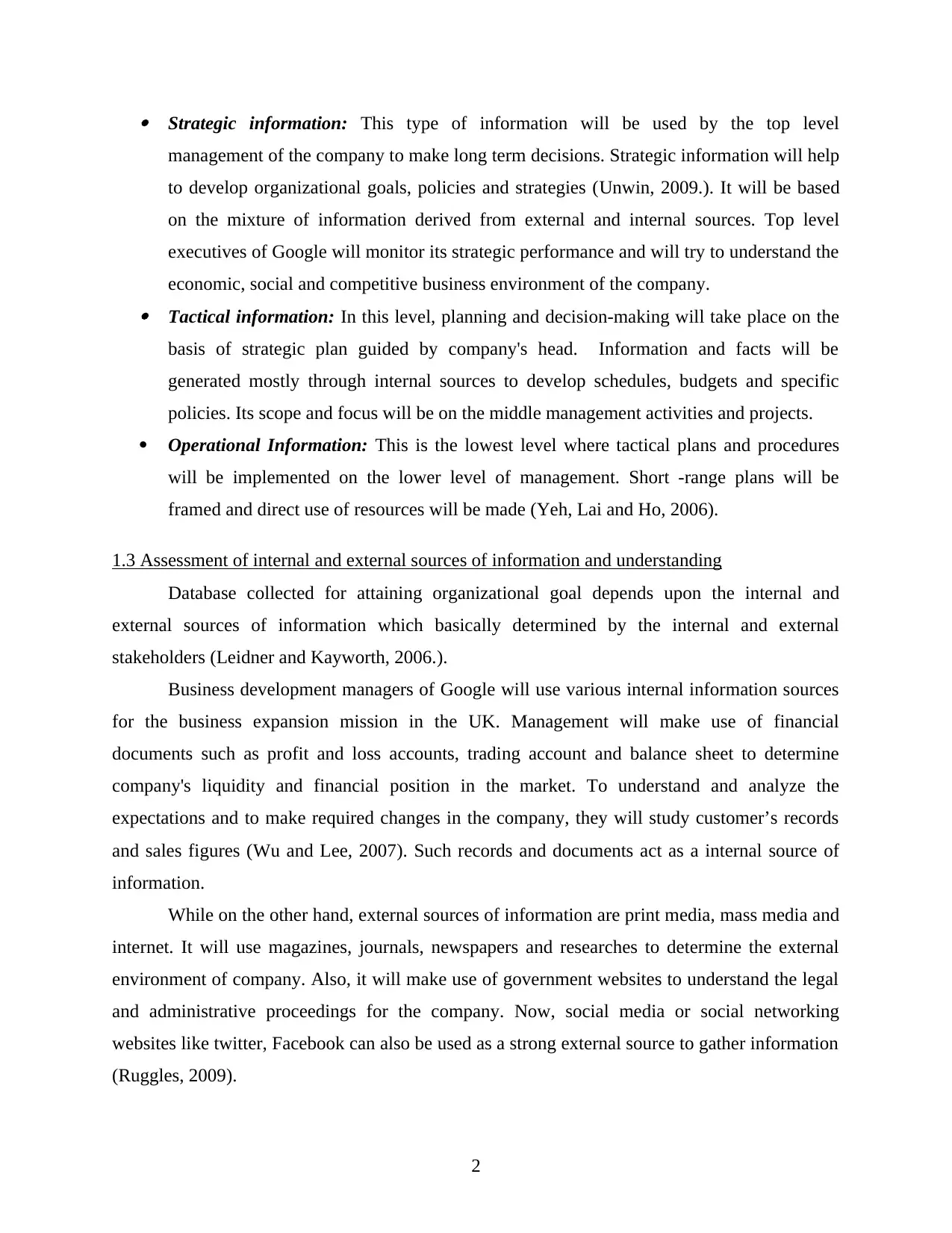
Strategic information: This type of information will be used by the top level
management of the company to make long term decisions. Strategic information will help
to develop organizational goals, policies and strategies (Unwin, 2009.). It will be based
on the mixture of information derived from external and internal sources. Top level
executives of Google will monitor its strategic performance and will try to understand the
economic, social and competitive business environment of the company. Tactical information: In this level, planning and decision-making will take place on the
basis of strategic plan guided by company's head. Information and facts will be
generated mostly through internal sources to develop schedules, budgets and specific
policies. Its scope and focus will be on the middle management activities and projects.
Operational Information: This is the lowest level where tactical plans and procedures
will be implemented on the lower level of management. Short -range plans will be
framed and direct use of resources will be made (Yeh, Lai and Ho, 2006).
1.3 Assessment of internal and external sources of information and understanding
Database collected for attaining organizational goal depends upon the internal and
external sources of information which basically determined by the internal and external
stakeholders (Leidner and Kayworth, 2006.).
Business development managers of Google will use various internal information sources
for the business expansion mission in the UK. Management will make use of financial
documents such as profit and loss accounts, trading account and balance sheet to determine
company's liquidity and financial position in the market. To understand and analyze the
expectations and to make required changes in the company, they will study customer’s records
and sales figures (Wu and Lee, 2007). Such records and documents act as a internal source of
information.
While on the other hand, external sources of information are print media, mass media and
internet. It will use magazines, journals, newspapers and researches to determine the external
environment of company. Also, it will make use of government websites to understand the legal
and administrative proceedings for the company. Now, social media or social networking
websites like twitter, Facebook can also be used as a strong external source to gather information
(Ruggles, 2009).
2
management of the company to make long term decisions. Strategic information will help
to develop organizational goals, policies and strategies (Unwin, 2009.). It will be based
on the mixture of information derived from external and internal sources. Top level
executives of Google will monitor its strategic performance and will try to understand the
economic, social and competitive business environment of the company. Tactical information: In this level, planning and decision-making will take place on the
basis of strategic plan guided by company's head. Information and facts will be
generated mostly through internal sources to develop schedules, budgets and specific
policies. Its scope and focus will be on the middle management activities and projects.
Operational Information: This is the lowest level where tactical plans and procedures
will be implemented on the lower level of management. Short -range plans will be
framed and direct use of resources will be made (Yeh, Lai and Ho, 2006).
1.3 Assessment of internal and external sources of information and understanding
Database collected for attaining organizational goal depends upon the internal and
external sources of information which basically determined by the internal and external
stakeholders (Leidner and Kayworth, 2006.).
Business development managers of Google will use various internal information sources
for the business expansion mission in the UK. Management will make use of financial
documents such as profit and loss accounts, trading account and balance sheet to determine
company's liquidity and financial position in the market. To understand and analyze the
expectations and to make required changes in the company, they will study customer’s records
and sales figures (Wu and Lee, 2007). Such records and documents act as a internal source of
information.
While on the other hand, external sources of information are print media, mass media and
internet. It will use magazines, journals, newspapers and researches to determine the external
environment of company. Also, it will make use of government websites to understand the legal
and administrative proceedings for the company. Now, social media or social networking
websites like twitter, Facebook can also be used as a strong external source to gather information
(Ruggles, 2009).
2
Paraphrase This Document
Need a fresh take? Get an instant paraphrase of this document with our AI Paraphraser
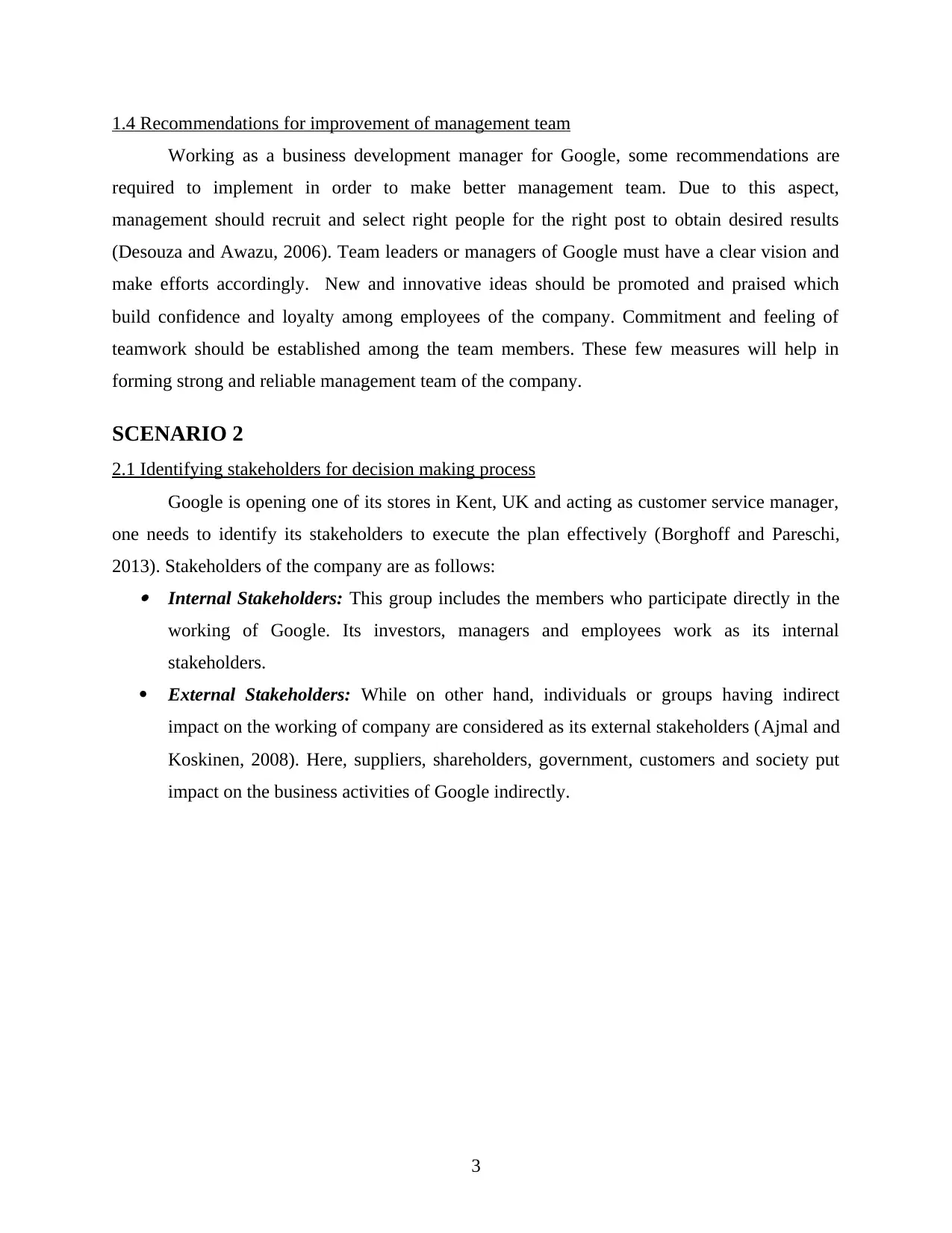
1.4 Recommendations for improvement of management team
Working as a business development manager for Google, some recommendations are
required to implement in order to make better management team. Due to this aspect,
management should recruit and select right people for the right post to obtain desired results
(Desouza and Awazu, 2006). Team leaders or managers of Google must have a clear vision and
make efforts accordingly. New and innovative ideas should be promoted and praised which
build confidence and loyalty among employees of the company. Commitment and feeling of
teamwork should be established among the team members. These few measures will help in
forming strong and reliable management team of the company.
SCENARIO 2
2.1 Identifying stakeholders for decision making process
Google is opening one of its stores in Kent, UK and acting as customer service manager,
one needs to identify its stakeholders to execute the plan effectively (Borghoff and Pareschi,
2013). Stakeholders of the company are as follows: Internal Stakeholders: This group includes the members who participate directly in the
working of Google. Its investors, managers and employees work as its internal
stakeholders.
External Stakeholders: While on other hand, individuals or groups having indirect
impact on the working of company are considered as its external stakeholders (Ajmal and
Koskinen, 2008). Here, suppliers, shareholders, government, customers and society put
impact on the business activities of Google indirectly.
3
Working as a business development manager for Google, some recommendations are
required to implement in order to make better management team. Due to this aspect,
management should recruit and select right people for the right post to obtain desired results
(Desouza and Awazu, 2006). Team leaders or managers of Google must have a clear vision and
make efforts accordingly. New and innovative ideas should be promoted and praised which
build confidence and loyalty among employees of the company. Commitment and feeling of
teamwork should be established among the team members. These few measures will help in
forming strong and reliable management team of the company.
SCENARIO 2
2.1 Identifying stakeholders for decision making process
Google is opening one of its stores in Kent, UK and acting as customer service manager,
one needs to identify its stakeholders to execute the plan effectively (Borghoff and Pareschi,
2013). Stakeholders of the company are as follows: Internal Stakeholders: This group includes the members who participate directly in the
working of Google. Its investors, managers and employees work as its internal
stakeholders.
External Stakeholders: While on other hand, individuals or groups having indirect
impact on the working of company are considered as its external stakeholders (Ajmal and
Koskinen, 2008). Here, suppliers, shareholders, government, customers and society put
impact on the business activities of Google indirectly.
3
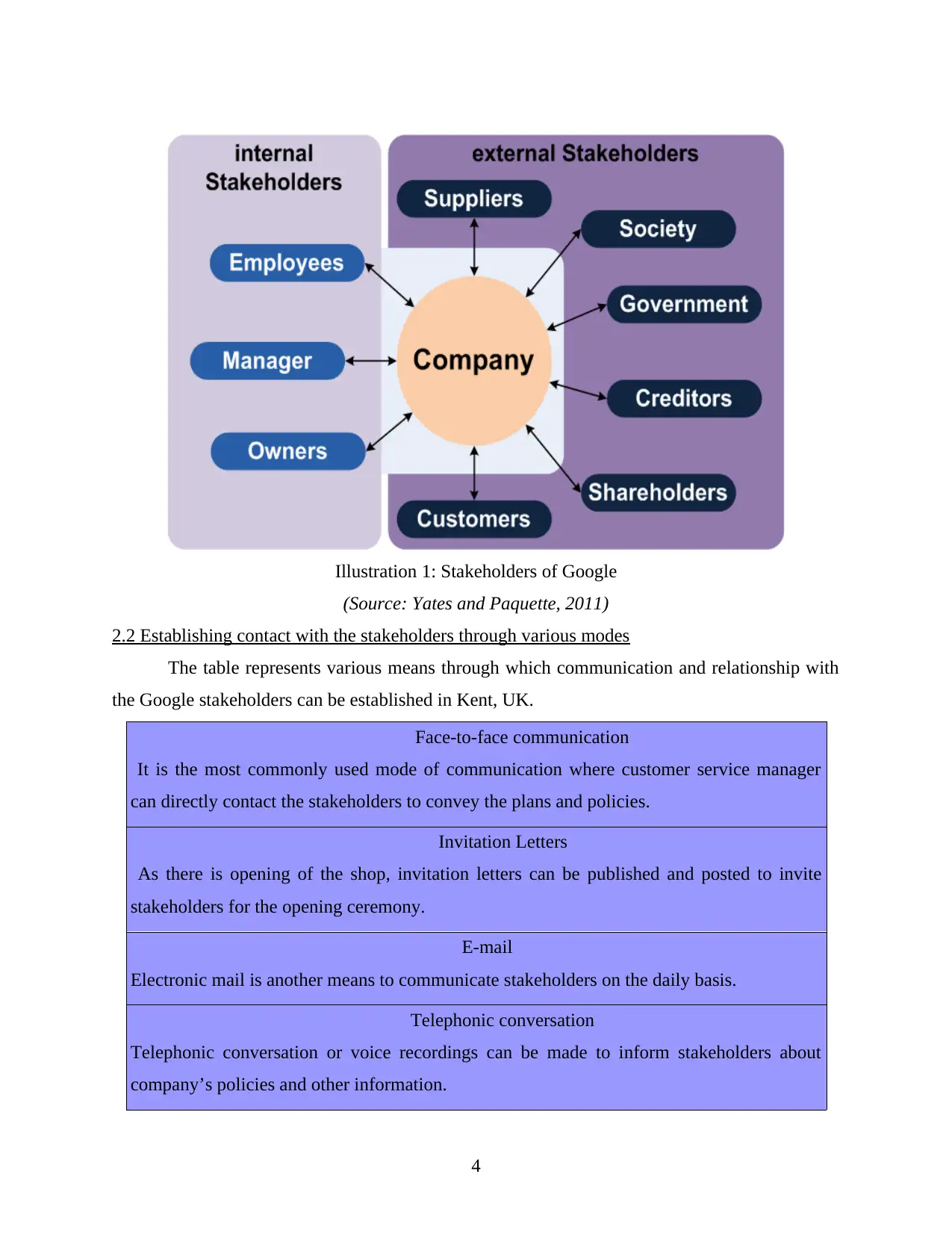
2.2 Establishing contact with the stakeholders through various modes
The table represents various means through which communication and relationship with
the Google stakeholders can be established in Kent, UK.
Face-to-face communication
It is the most commonly used mode of communication where customer service manager
can directly contact the stakeholders to convey the plans and policies.
Invitation Letters
As there is opening of the shop, invitation letters can be published and posted to invite
stakeholders for the opening ceremony.
E-mail
Electronic mail is another means to communicate stakeholders on the daily basis.
Telephonic conversation
Telephonic conversation or voice recordings can be made to inform stakeholders about
company’s policies and other information.
4
Illustration 1: Stakeholders of Google
(Source: Yates and Paquette, 2011)
The table represents various means through which communication and relationship with
the Google stakeholders can be established in Kent, UK.
Face-to-face communication
It is the most commonly used mode of communication where customer service manager
can directly contact the stakeholders to convey the plans and policies.
Invitation Letters
As there is opening of the shop, invitation letters can be published and posted to invite
stakeholders for the opening ceremony.
Electronic mail is another means to communicate stakeholders on the daily basis.
Telephonic conversation
Telephonic conversation or voice recordings can be made to inform stakeholders about
company’s policies and other information.
4
Illustration 1: Stakeholders of Google
(Source: Yates and Paquette, 2011)
⊘ This is a preview!⊘
Do you want full access?
Subscribe today to unlock all pages.

Trusted by 1+ million students worldwide
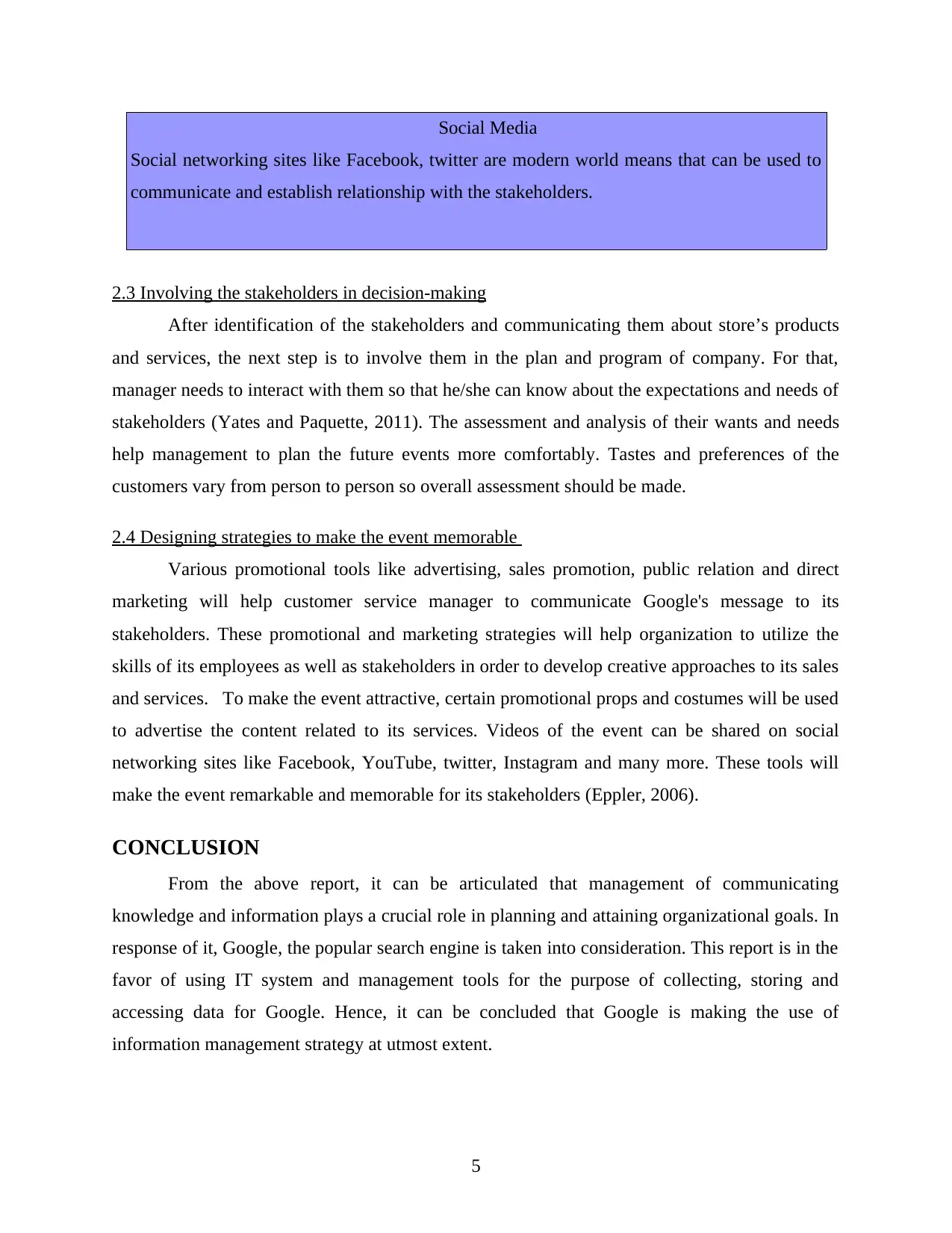
Social Media
Social networking sites like Facebook, twitter are modern world means that can be used to
communicate and establish relationship with the stakeholders.
2.3 Involving the stakeholders in decision-making
After identification of the stakeholders and communicating them about store’s products
and services, the next step is to involve them in the plan and program of company. For that,
manager needs to interact with them so that he/she can know about the expectations and needs of
stakeholders (Yates and Paquette, 2011). The assessment and analysis of their wants and needs
help management to plan the future events more comfortably. Tastes and preferences of the
customers vary from person to person so overall assessment should be made.
2.4 Designing strategies to make the event memorable
Various promotional tools like advertising, sales promotion, public relation and direct
marketing will help customer service manager to communicate Google's message to its
stakeholders. These promotional and marketing strategies will help organization to utilize the
skills of its employees as well as stakeholders in order to develop creative approaches to its sales
and services. To make the event attractive, certain promotional props and costumes will be used
to advertise the content related to its services. Videos of the event can be shared on social
networking sites like Facebook, YouTube, twitter, Instagram and many more. These tools will
make the event remarkable and memorable for its stakeholders (Eppler, 2006).
CONCLUSION
From the above report, it can be articulated that management of communicating
knowledge and information plays a crucial role in planning and attaining organizational goals. In
response of it, Google, the popular search engine is taken into consideration. This report is in the
favor of using IT system and management tools for the purpose of collecting, storing and
accessing data for Google. Hence, it can be concluded that Google is making the use of
information management strategy at utmost extent.
5
Social networking sites like Facebook, twitter are modern world means that can be used to
communicate and establish relationship with the stakeholders.
2.3 Involving the stakeholders in decision-making
After identification of the stakeholders and communicating them about store’s products
and services, the next step is to involve them in the plan and program of company. For that,
manager needs to interact with them so that he/she can know about the expectations and needs of
stakeholders (Yates and Paquette, 2011). The assessment and analysis of their wants and needs
help management to plan the future events more comfortably. Tastes and preferences of the
customers vary from person to person so overall assessment should be made.
2.4 Designing strategies to make the event memorable
Various promotional tools like advertising, sales promotion, public relation and direct
marketing will help customer service manager to communicate Google's message to its
stakeholders. These promotional and marketing strategies will help organization to utilize the
skills of its employees as well as stakeholders in order to develop creative approaches to its sales
and services. To make the event attractive, certain promotional props and costumes will be used
to advertise the content related to its services. Videos of the event can be shared on social
networking sites like Facebook, YouTube, twitter, Instagram and many more. These tools will
make the event remarkable and memorable for its stakeholders (Eppler, 2006).
CONCLUSION
From the above report, it can be articulated that management of communicating
knowledge and information plays a crucial role in planning and attaining organizational goals. In
response of it, Google, the popular search engine is taken into consideration. This report is in the
favor of using IT system and management tools for the purpose of collecting, storing and
accessing data for Google. Hence, it can be concluded that Google is making the use of
information management strategy at utmost extent.
5
Paraphrase This Document
Need a fresh take? Get an instant paraphrase of this document with our AI Paraphraser

REFERENCES
Books and Journals
Ajmal, M. M. and Koskinen, K. U., 2008. Knowledge transfer in project‐based organizations: an
organizational culture perspective. Project Management Journal. 39(1). pp.7-15.
Borghoff, U. M. and Pareschi, R., 2013. Information technology for knowledge management.
Springer Science & Business Media.
Wu, W. W. and Lee, Y. T., 2007. Selecting knowledge management strategies by using the
analytic network process. Expert systems with Applications. 32(3). pp.841-847.
De Vries, R. E., Hooff, B. and Ridder, J.A., 2006. Explaining knowledge sharing the role of
team communication styles, job satisfaction, and performance beliefs. Communication
research. 33(2). pp.115-135.
Desouza, K. C. and Awazu, Y., 2006. Knowledge management at SMEs: five
peculiarities. Journal of knowledge management. 10(1). pp.32-43.
Eppler, M. J., 2006. Managing information quality: Increasing the value of information in
knowledge-intensive products and processes. Springer Science & Business Media.
Leidner, D. E. and Kayworth, T., 2006. Review: a review of culture in information systems
research: toward a theory of information technology culture conflict. MIS
quarterly. 30(2). pp.357-399.
Nonaka, I., 2008. The knowledge-creating company. Harvard Business Review Press.
Ruggles, R., 2009. Knowledge management tools. Routledge.
Unwin, P.T.H. ed., 2009. ICT4D: Information and communication technology for development.
Cambridge University Press.
Yates, D. and Paquette, S., 2011. Emergency knowledge management and social media
technologies: A case study of the 2010 Haitian earthquake. International journal of
information management. 31(1). pp.6-13.
Yeh, Y. J., Lai, S .Q. and Ho, C. T., 2006. Knowledge management enablers: a case
study. Industrial Management & Data Systems. 106(6). pp.793-810.
6
Books and Journals
Ajmal, M. M. and Koskinen, K. U., 2008. Knowledge transfer in project‐based organizations: an
organizational culture perspective. Project Management Journal. 39(1). pp.7-15.
Borghoff, U. M. and Pareschi, R., 2013. Information technology for knowledge management.
Springer Science & Business Media.
Wu, W. W. and Lee, Y. T., 2007. Selecting knowledge management strategies by using the
analytic network process. Expert systems with Applications. 32(3). pp.841-847.
De Vries, R. E., Hooff, B. and Ridder, J.A., 2006. Explaining knowledge sharing the role of
team communication styles, job satisfaction, and performance beliefs. Communication
research. 33(2). pp.115-135.
Desouza, K. C. and Awazu, Y., 2006. Knowledge management at SMEs: five
peculiarities. Journal of knowledge management. 10(1). pp.32-43.
Eppler, M. J., 2006. Managing information quality: Increasing the value of information in
knowledge-intensive products and processes. Springer Science & Business Media.
Leidner, D. E. and Kayworth, T., 2006. Review: a review of culture in information systems
research: toward a theory of information technology culture conflict. MIS
quarterly. 30(2). pp.357-399.
Nonaka, I., 2008. The knowledge-creating company. Harvard Business Review Press.
Ruggles, R., 2009. Knowledge management tools. Routledge.
Unwin, P.T.H. ed., 2009. ICT4D: Information and communication technology for development.
Cambridge University Press.
Yates, D. and Paquette, S., 2011. Emergency knowledge management and social media
technologies: A case study of the 2010 Haitian earthquake. International journal of
information management. 31(1). pp.6-13.
Yeh, Y. J., Lai, S .Q. and Ho, C. T., 2006. Knowledge management enablers: a case
study. Industrial Management & Data Systems. 106(6). pp.793-810.
6
1 out of 8
Related Documents
Your All-in-One AI-Powered Toolkit for Academic Success.
+13062052269
info@desklib.com
Available 24*7 on WhatsApp / Email
![[object Object]](/_next/static/media/star-bottom.7253800d.svg)
Unlock your academic potential
Copyright © 2020–2025 A2Z Services. All Rights Reserved. Developed and managed by ZUCOL.





